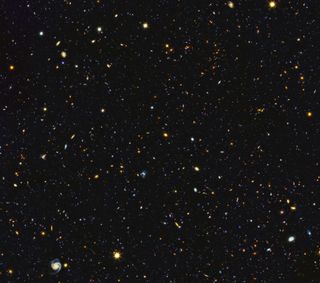15,000 Galaxies Shine in This 1 View from the Hubble Space Telescope

The Hubble Space Telescope has been at work for almost three decades, but it's still learning new skills — like how to squeeze an incredible 15,000 galaxies into a single image.
That's the feat Hubble accomplished in a new pair of images the team behind the telescope published on Aug. 16.
The telescope could catch so many galaxies at once because it relied on ultraviolet light and teamed up with other telescopes on the ground and in space. With that information, Hubble could build the most detailed picture possible of the universe around us, according to a statement published by the team behind the telescope.

Hubble's new images are part of a campaign called Hubble Deep UV Legacy Survey, which is focused on the telescope's ultraviolet imaging capability.
That range of wavelengths is a crucial part of the light spectrum to gather data in, because it struggles to make its way through Earth's atmosphere — so a space-based telescope like Hubble can give us a whole new view of galaxies, the statement continues.

That takes scientists back to the universe's peak star-forming period, giving them a view of both galaxies that are quite faint and those that are brighter. In time, images like these should help scientists better understand how galaxies age, the team behind the new photographs wrote in an accompanying scientific paper published in the Astrophysical Journal Supplement Series in July.In the case of these images, that ultraviolet light helps scientists travel backward through time. By combining this ultraviolet data with other wavelengths, scientists can create images so comprehensive that the researchers can study 12,000 different star-forming galaxies as they evolve over about 11 billion years.
Email Meghan Bartels at mbartels@space.com or follow her @meghanbartels. Follow us @Spacedotcom, Facebook and Google+. Original article on Space.com.
Sign up for the Live Science daily newsletter now
Get the world’s most fascinating discoveries delivered straight to your inbox.
Meghan is a senior writer at Space.com and has more than five years' experience as a science journalist based in New York City. She joined Space.com in July 2018, with previous writing published in outlets including Newsweek and Audubon. Meghan earned an MA in science journalism from New York University and a BA in classics from Georgetown University, and in her free time she enjoys reading and visiting museums. Follow her on Twitter at @meghanbartels.

